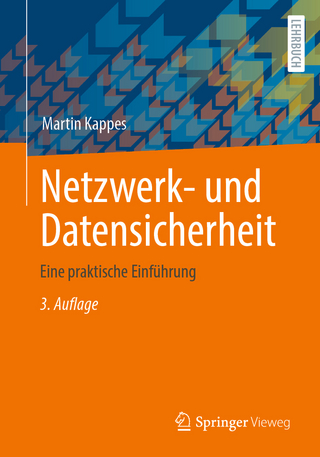
Modern Security Operations Center, The
Addison Wesley (Verlag)
978-0-13-561985-8 (ISBN)
This completely new, vendor-neutral guide brings together all the knowledge you need to build, maintain, and operate a modern Security Operations Center (SOC) and deliver security services as efficiently and cost-effectively as possible.
Leading security architect Joseph Muniz helps you assess current capabilities, align your SOC to your business, and plan a new SOC or evolve an existing one. He covers people, process, and technology; explores each key service handled by mature SOCs; and offers expert guidance for managing risk, vulnerabilities, and compliance. Throughout, hands-on examples show how advanced red and blue teams execute and defend against real-world exploits using tools like Kali Linux and Ansible. Muniz concludes by previewing the future of SOCs, including Secure Access Service Edge (SASE) cloud technologies and increasingly sophisticated automation.
This guide will be indispensable for everyone responsible for delivering security services—managers and cybersecurity professionals alike.
Address core business and operational requirements, including sponsorship, management, policies, procedures, workspaces, staffing, and technology
Identify, recruit, interview, onboard, and grow an outstanding SOC team
Thoughtfully decide what to outsource and what to insource
Collect, centralize, and use both internal data and external threat intelligence
Quickly and efficiently hunt threats, respond to incidents, and investigate artifacts
Reduce future risk by improving incident recovery and vulnerability management
Apply orchestration and automation effectively, without just throwing money at them
Position yourself today for emerging SOC technologies
Joseph Muniz is an architect and security researcher in the Cisco Security Sales and Engineering Organization. He is driven by making the world a safer place through education and adversary research. Joseph has extensive experience in designing security solutions and architectures as a trusted advisor for top Fortune 500 corporations and the U.S. government. Joseph is a researcher and industry thought leader. He speaks regularly at international conferences, writes for technical magazines, and is involved with developing training for various industry certifications. He invented the fictitious character of Emily Williams to create awareness around social engineering. Joseph runs The Security Blogger website, a popular resource for security and product implementation. He is the author and contributor of several publications including titles ranging from security best practices to exploitation tactics. When Joseph is not using technology, you can find him on the fútbol (soccer) field or raising the next generation of hackers, also known as his children. Follow Joseph at https://www.thesecurityblogger.com and @SecureBlogger
Preface
Chapter 1: Introducing Security Operations and the SOC
Introducing the SOC
Factors Leading to a Dysfunctional SOC
Cyberthreats
Investing in Security
The Impact of a Breach
Establishing a Baseline
The Impact of Change
Fundamental Security Capabilities
Signature Detection
Behavior Detection
Anomaly Detection
Best of Breed vs. Defense in Depth
Standards, Guidelines, and Frameworks
NIST Cybersecurity Framework
ISO 3100:2018
FIRST Service Frameworks
Applying Frameworks
Industry Threat Models
The Cyber Kill Chain Model
The Diamond Model
MITRE ATT&CK Model
Choosing a Threat Model
Vulnerabilities and Risk
Endless Vulnerabilities
Business Challenges
In-House vs. Outsourcing
Services Advantages
Services Disadvantages
Hybrid Services
SOC Services
SOC Maturity Models
SOC Maturity Assessment
SOC Program Maturity
SOC Goals Assessment
Defining Goals
SOC Goals Ranking
Threats Ranking
SOC Goals Assessment Summarized
SOC Capabilities Assessment
Capability Maps
SOC Capabilities Gaps Analysis
Capability Map Next Steps
SOC Development Milestones
Summary
References
Chapter 2: Developing a Security Operations Center
Mission Statement and Scope Statement
Developing Mission and Scope Statements
SOC Scope Statement
Developing a SOC
SOC Procedures
Designing Procedures
Security Tools
Evaluating Vulnerabilities
Preventive Technologies
Detection Technologies
Mobile Device Security Concerns
Planning a SOC
Capacity Planning
Developing a Capacity Plan
Designing a SOC Facility
Physical SOC vs. Virtual SOC
SOC Location
SOC Interior
SOC Rooms
SOC Computer Rooms
SOC Layouts
Network Considerations
Segmentation
Logical Segmentation
Choosing Segmentation
Client/Server Segmentation
Active Directory Segmentation
Throughput
Connectivity and Redundancy
Disaster Recovery
Security Considerations
Policy and Compliance
Network Access Control
Encryption
Internal Security Tools
Intrusion Detection and Prevention
Network Flow and Capturing Packets
Change Management
Host Systems
Guidelines and Recommendations for Securing Your SOC Network
Tool Collaboration
SOC Tools
Reporting and Dashboards
Throughput and Storage
Centralized Data Management
Summary
References
Chapter 3: SOC Services
Fundamental SOC Services
SOC Challenges
The Three Pillars of Foundational SOC Support Services
Pillar 1: Work Environment
Pillar 2: People
Pillar 3: Technology
Evaluating the Three Pillars of Foundational SOC Support Services
SOC Service Areas
FIRST’s CSIRT
Developing SOC Service Areas
In-House Services vs. External Services
Contracted vs. Employee Job Roles
SOC Service Job Goals
Resource Planning
Service Maturity: If You Build It, They Will Come
SOC Service 1: Risk Management
Four Responses to Risk
Reducing Risk
Addressing Risk
SOC Service 2: Vulnerability Management
Vulnerability Management Best Practice
Vulnerability Scanning Tools
Penetration Testing
SOC Service 3: Compliance
Meeting Compliance with Audits
SOC Service 4: Incident Management
NIST Special Publication 800-61 Revision 2
Incident Response Planning
Incident Impact
Playbooks
SOC Service 5: Analysis
Static Analysis
Dynamic Analysis
SOC Service 6: Digital Forensics
SOC Service 7: Situational and Security Awareness
User Training
SOC Service 8: Research and Development
Summary
References
Chapter 4: People and Process
Career vs. Job
Developing Job Roles
General Schedule Pay Scale
IT Industry Job Roles
Common IT Job Roles
SOC Job Roles
Security Analyst
Penetration Tester
Assessment Officer
Incident Responder
Systems Analyst
Security Administrator
Security Engineer
Security Trainer
Security Architect
Cryptographer/Cryptologist
Forensic Engineer
Chief Information Security Officer
NICE Cybersecurity Workforce Framework
Nice Framework Components
Role Tiers
SOC Services and Associated Job Roles
Risk Management Service
Vulnerability Management Service
Incident Management Service
Analysis Service
Compliance Service
Digital Forensics Service
Situational and Security Awareness Service
Research and Development Service
Soft Skills
Evaluating Soft Skills
SOC Soft Skills
Security Clearance Requirements
Pre-Interviewing
Interviewing
Interview Prompter
Post Interview
Onboarding Employees
Onboarding Requirements
Managing People
Job Retention
Training
Training Methods
Certifications
Company Culture
Summary
References
Chapter 5: Centralizing Data
Data in the SOC
Strategic and Tactical Data
Data Structure
Data Types
Data Context
Data-Focused Assessment
Data Assessment Example: Antivirus
Threat Mapping Data
Applying Data Assessments to SOC Services
Logs
Log Types
Log Formats
Security Information and Event Management
SIEM Data Processing
Data Correlation
Data Enrichment
SIEM Solution Planning
SIEM Tuning
Troubleshooting SIEM Logging
SIEM Troubleshooting Part 1: Data Input
SIEM Troubleshooting Part 2: Data Processing and Validation
SIEM Troubleshooting Examples
Additional SIEM Features
APIs
Leveraging APIs
API Architectures
API Examples
Big Data
Hadoop
Big Data Threat Feeds
Machine Learning
Machine Learning in Cybersecurity
Artificial Intelligence
Machine Learning Models
Summary
References
Chapter 6: Reducing Risk and Exceeding Compliance
Why Exceeding Compliance
Policies
Policy Overview
Policy Purpose
Policy Scope
Policy Statement
Policy Compliance
Related Standards, Policies, Guidelines, and Processes
Definitions and Terms
History
Launching a New Policy
Steps for Launching a New Policy
Policy Enforcement
Certification and Accreditation
Procedures
Procedure Document
Tabletop Exercise
Tabletop Exercise Options
Tabletop Exercise Execution
Tabletop Exercise Format
Tabletop Exercise Template Example
Standards, Guidelines, and Frameworks
NIST Cybersecurity Framework
ISO/IEC 27005
CIS Controls
ISACA COBIT 2019
FIRST CSIRT Services Framework
Exceeding Compliance
Audits
Audit Example
Internal Audits
External Auditors
Audit Tools
Assessments
Assessment Types
Assessment Results
Assessment Template
Vulnerability Scanners
Assessment Program Weaknesses
Penetration Test
NIST Special Publication 800-115
Additional NIST SP 800-115 Guidance
Penetration Testing Types
Penetration Testing Planning
Industry Compliance
Compliance Requirements
Summary
References
Chapter 7: Threat Intelligence
Threat Intelligence Overview
Threat Data
Threat Intelligence Categories
Strategic Threat Intelligence
Tactical Threat Intelligence
Operational Threat Intelligence
Technical Threat Intelligence
Threat Intelligence Context
Threat Context
Evaluating Threat Intelligence
Threat Intelligence Checklist
Content Quality
Testing Threat Intelligence
Planning a Threat Intelligence Project
Data Expectations for Strategic Threat Intelligence
Data Expectations for Tactical Threat Intelligence
Data Expectations for Operational Threat Intelligence
Data Expectations for Technical Threat Intelligence
Collecting and Processing Intelligence
Processing Nontechnical Data
Operational Data and Web Processing
Technical Processing
Technical Threat Intelligence Resources
Actionable Intelligence
Security Tools and Threat Intelligence
Feedback
Summary
References
Chapter 8: Threat Hunting and Incident Response
Security Incidents
Incident Response Lifecycle
Phase 1: Preparation
Assigning Tasks with Playbooks
Communication
Third-Party Interaction
Law Enforcement
Law Enforcement Risk
Ticketing Systems
Other Incident Response Planning Templates
Phase 1: Preparation Summary
Phase 2: Detection and Analysis
Incident Detection
Core Security Capabilities
Threat Analysis
Detecting Malware Behavior
Infected Systems
Analyzing Artifacts
Identifying Artifact Types
Packing Files
Basic Static Analysis
Advanced Static Analysis
Dynamic Analysis
Phase 2: Detection and Analysis Summary
Phase 3: Containment, Eradication, and Recovery
Containment
Responding to Malware
Threat Hunting Techniques
Eradicate
Recovery
Digital Forensics
Digital Forensic Process
First Responder
Chain of Custody
Working with Evidence
Duplicating Evidence
Hashes
Forensic Static Analysis
Recovering Data
Forensic Dynamic Analysis
Digital Forensics Summary
Phase 3: Containment, Eradication, and Recovery Summary
Phase 4: Post-Incident Activity
Post-Incident Response Process
Phase 4: Post-Incident Response Summary
Incident Response Guidelines
FIRST Services Frameworks
Summary
References
Chapter 9: Vulnerability Management
Vulnerability Management
Phase 1: Asset Inventory
Phase 2: Information Management
Phase 3: Risk Assessment
Phase 4: Vulnerability Assessment
Phase 5: Report and Remediate
Phase 6: Respond and Repeat
Measuring Vulnerabilities
Common Vulnerabilities and Exposures
Common Vulnerability Scoring System
CVSS Standards
Vulnerability Technology
Vulnerability Scanners
Currency and Coverage
Tuning Vulnerability Scanners
Exploitation Tools
Asset Management and Compliance Tools
Network Scanners and Network Access Control
Threat Detection Tools
Vulnerability Management Service
Scanning Services
Vulnerability Management Service Roles
Vulnerability Evaluation Procedures
Vulnerability Response
Vulnerability Accuracy
Responding to Vulnerabilities
Cyber Insurance
Patching Systems
Residual Risk
Remediation Approval
Reporting
Exceptions
Vulnerability Management Process Summarized
Summary
References
Chapter 10: Data Orchestration
Introduction to Data Orchestration
Comparing SIEM and SOAR
The Rise of XDR
Security Orchestration, Automation, and Response
SOAR Example: Phantom
Endpoint Detection and Response
EDR Example: CrowdStrike
Playbooks
Playbook Components
Constructing Playbooks
Incident Response Consortium
Playbook Examples: Malware Outbreak
Automation
Automating Playbooks
Common Targets for Automation
Automation Pitfalls
Playbook Workflow
DevOps Programming
Data Management
Text-File Formats
Common Data Formats
Data Modeling
DevOps Tools
DevOps Targets
Manual DevOps
Automated DevOps
DevOps Lab Using Ansible
Ansible Playbooks
Blueprinting with Osquery
Running Osquery
Network Programmability
Learning NetDevOps
APIs
NetDevOps Example
Cloud Programmability
Orchestration in the Cloud
Amazon DevOps
SaaS DevOps
Summary
References
Chapter 11: Future of the SOC
All Eyes on SD-WAN and SASE
VoIP Adoption As Prologue to SD-WAN Adoption
Introduction of SD-WAN
Challenges with the Traditional WAN
SD-WAN to the Rescue
SASE Solves SD-WAN Problems
SASE Defined
Future of SASE
IT Services Provided by the SOC
IT Operations Defined
Hacking IT Services
IT Services Evolving
Future of IT Services
Future of Training
Training Challenges
Training Today
Case Study: Training I Use Today
Free Training
Gamifying Learning
On-Demand and Personalized Learning
Future of Training
Full Automation with Machine Learning
Machine Learning
Machine Learning Hurdles
Machine Learning Applied
Training Machine Learning
Future of Machine Learning
Future of Your SOC: Bringing It All Together
Your Future Facilities and Capabilities
Group Tags
Your Future SOC Staff
Audits, Assessments, and Penetration Testing
Future Impact to Your Services
Hunting for Tomorrow’s Threats
Summary
References
9780135619858 TOC 3/24/2021
| Erscheinungsdatum | 29.10.2019 |
|---|---|
| Verlagsort | Boston |
| Sprache | englisch |
| Maße | 179 x 232 mm |
| Gewicht | 1310 g |
| Themenwelt | Informatik ► Netzwerke ► Sicherheit / Firewall |
| ISBN-10 | 0-13-561985-8 / 0135619858 |
| ISBN-13 | 978-0-13-561985-8 / 9780135619858 |
| Zustand | Neuware |
| Haben Sie eine Frage zum Produkt? |
aus dem Bereich


